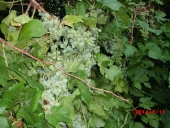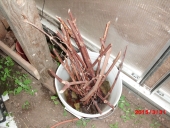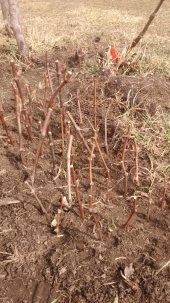
 6
6




Pecan Media: food forestry and forest garden ebooks
Now available: The Native Persimmon (centennial edition)
 5
5




To lead a tranquil life, mind your own business and work with your hands.




"Disturbance is critical" Joel Salatin
 1
1
 1
1




This is all just my opinion based on a flawed memory

 3
3
 1
1




 1
1




Jan Hrbek wrote:Yes, It is crazy and it won´t work. You must have shoot with one bud at least to get a seedling with roots. There are no sleeping buds on the bunch, so it will not root. Sorry, bad idea.
Pecan Media: food forestry and forest garden ebooks
Now available: The Native Persimmon (centennial edition)
 1
1




Chris Wang wrote:Tissue culture cloning is possible.
Pecan Media: food forestry and forest garden ebooks
Now available: The Native Persimmon (centennial edition)
 1
1
 1
1




"The only thing...more expensive than education is ignorance."~Ben Franklin. "We can easily forgive a child who is afraid of the dark; the real tragedy of life is when men are afraid of the light." ~ Plato
 2
2




Standing on the shoulders of giants. Giants with dirt under their nails
 1
1




 4
4




Carla Burke wrote:Ehhh... why not just plant the seeds?
Pecan Media: food forestry and forest garden ebooks
Now available: The Native Persimmon (centennial edition)
 2
2




Tj Jefferson wrote:Dan,
In my modest experience, most of the new varieties of grape are really prone to mildew. Sulfur continues to be considered organic, so it may not bother you. I am far too lazy.
Pecan Media: food forestry and forest garden ebooks
Now available: The Native Persimmon (centennial edition)
 1
1




This is all just my opinion based on a flawed memory

 1
1




Pecan Media: food forestry and forest garden ebooks
Now available: The Native Persimmon (centennial edition)
 1
1
 1
1




This is all just my opinion based on a flawed memory

 1
1




Ben Zumeta wrote:My main advice is if you really want to come up with a grape better than 6000yrs of breeding and care...
Pecan Media: food forestry and forest garden ebooks
Now available: The Native Persimmon (centennial edition)




This is all just my opinion based on a flawed memory










|
30 seconds to difuse a loaf of bread ... here, use this tiny ad:
Freaky Cheap Heat - 2 hour movie - HD streaming
https://permies.com/wiki/238453/Freaky-Cheap-Heat-hour-movie
|






